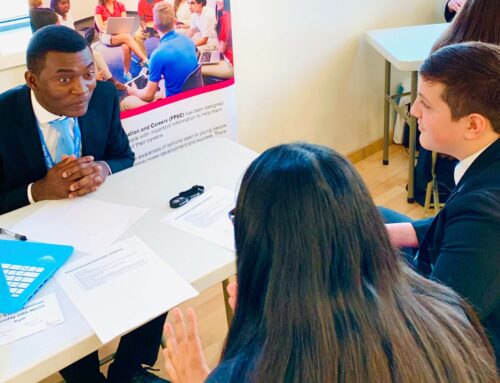
Undertaking CPD is not just about going on a course; being open to trying new ways of learning is an important skill to develop. Last time in the A-Z of CPD series we looked at a range of different activities from ‘peer review’ to ‘questioning colleagues’. This week we help you consider alternative activities that you can do as part of your own continuous professional development, starting at the letter ‘R’.
Taken from CPD for the Career Development Professional by Siobhan Neary and Claire Johnson.

R
REFLECTION ON PRACTICE
What this is:
This is the process through which we examine our practice and learn from what we observe. It is a critical activity whereby we use opportunities that we feel have worked well and those that worked less well to examine what contributed to the successful or less successful outcome. This activity is closely linked to experiential learning.
How can this be used as CPD:
This is a core activity for the professional career development practitioner. It can be used after an interview or a group work activity to assess what worked well, whether the participant(s) got what they needed from the interaction, and what you can do to improve for next time.
Useful examples/websites:
- Bassot, B. (2013). The Reflective Journal. London: Palgrave Macmillan.
- Findley, L. (2008). Reflecting on Reflective Practice. Milton Keynes: The Open University. Paper 52 Practice Based Professional Learning Centre. Available at: https://www.open.ac.uk/opencetl/sites/www.open.ac.uk.opencetl/files/files/ecms/web-content/Finlay-(2008)-Reflecting-on-reflective-practice-PBPL-paper-52.pdf.
- Smith, M. (1999). Reflection, learning and education. Infed. Available at: http://infed.org/mobi/reflection-learning-and-education.
RESEARCH
What this is:
There are many different definitions used to describe research, but it is basically a systematic approach used for solving a problem or creating new knowledge. It consists of a set of techniques that can be applied within different contexts to investigate/explore/examine an area of interest.
How this can be used as CPD:
Research can be used in many ways. You can read research reports to find out what is new in the careers world; you can undertake your own research project to investigate any problem or an idea you might have; and you can contribute to research projects and share your views.
Useful examples/websites:
- CDI News via Email (members only)
- NICEC: http://www.nicec.org/nicec-journal
- iCeGS: derby.ac.uk/icegs
- NGRF: warwick.ac.uk/fac/soc/ier/ngrf
- Institute for Employment Studies: employment-studies.co.uk
- Warwick Institute for Employment Research: warwick.ac.uk/fac/soc/ier/research
- Centre for Career and Personal Development: https://www.canterbury.ac.uk/education/our-work/centre-for-career-and-personal-development/centre-for-career-and-personal-development.aspx
S
SECONDMENT
What this is:
Secondment is the temporary transfer of a practitioner to another position or department.
How this can be used as CPD:
A secondment can give you the opportunity for wider career and personal development than in your day-to-day work. It can help you to acquire valuable experience in project management and provide the opportunity to test and apply specific skills in a different organisational environment. You can also gain new skills and experiences in more challenging areas. It can improve your team skills and add valuable contacts to your professional network.
SEMINARS
What this is:
Seminars are a form of instruction, bringing together small groups for recurring meetings, focusing each time on a particular subject, in which everyone present is requested to actively participate.
How this can be used as CPD:
Attending a seminar can enhance your knowledge of a particular subject, both from the seminar leader and your fellow participants. Leading a seminar can do this too, as you will need to research your topic and will learn from the views of the participants.
Useful examples/websites:
- NICEC: nicec.org/events
SOCIAL MEDIA
What this is:
These are computer-mediated tools facilitating opportunities to create, share and exchange information and resources.
How this can be used as CPD:
Social media is a really useful way to extend your network through participating in discussion forums.
Useful examples/websites:
SUPERVISION
What this is:
Supervision is a positive and enabling process that brings a practitioner and a skilled supervisor together to reflect on work practice. It is the process by which a practitioner can review and evaluate their work through discussion, reporting and observation with another worker. Supervision aims to identify solutions to problems, improve practice and increase understanding of professional issues.
How this can be used as CPD:
Supervision helps you to develop knowledge and skills and to reflect on your practice and its adherence to a relevant code of ethics. It helps to ensure that professional standards are maintained and that policies and procedures of the organisation are adhered to. It is underpinned by learning from experience and reflective practice. Engaging with an experienced worker who is prepared to help you look critically at what you do can help you to gain a better understanding, in professional terms, of your work situation. It helps you to keep your practice fresh and to manage the pressures of your role.
T
TEACHING
What this is:
This can be formal and informal, and involves the imparting of skills and/or knowledge to others.
How this can be used as CPD:
Preparing for a teaching session, including thinking through how you will meet the learning needs of your audience, is a useful source of CPD as it enables you to research your subject matter and synthesise and interpret this so that others may benefit. The actual act of teaching and discussion with the learners can also add their perspectives to your own knowledge.
TED TALKS
What this is:
This is a large bank of inspiring and sometimes offbeat talks, typically of about 20 minutes’ duration, which can be searched by topic.
How this can be used as CPD:
Having analysed your CPD needs, you can search the TED website to see if there are any TED Talks that meet your needs. Alternatively, looking through what is there can help improve your spirit of enquiry and curiosity, and you never know what you might find that helps you with your professional practice.
Useful examples/websites:
- ted.com/talks
- Body language example: ted.com/talks?q=amy+cuddy&sort=newest
TRAINING SESSION
What this is:
An event run on a particular topic. These may be made compulsory by an employer and cover such topics as legislation or new company working practices, or they may be sessions that you choose to do having analysed your own CPD needs. Training events can be non-accredited or may be part of a formal programme of learning, leading to a qualification.
How this can be used as CPD:
These can be a valuable source of learning and help to develop skills and knowledge. You can also use them as an opportunity to network; it is worth thinking through beforehand who will be attending the event and some questions that you would like to ask of the people you meet.
Useful examples/websites:
- thecdi.net/Developing-Yourself
- agcas.org.uk/events?category=agcas_e
- http://shop.cipd.co.uk/shop/cipd-training/
What this is:
Twitter is an online social networking service that enables users to send and read short 140-character messages called ‘tweets’.
How this can be used as CPD:
Twitter can be used as a means of keeping yourself up to date with sector developments by following key people or organisations. It can also alert you to training opportunities and other CPD events.
Useful examples/websites:
- https://twitter.com/?lang=en-gb @theCDI

Emma Davies works within the editorial department at Trotman Publishing. Graduating from her Masters degree in 2017, she is familiar with all aspects of the student journey through university. She is passionate about helping students find the right career, and was a member of the SYP’s inaugural committee in the South West.





